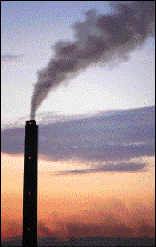Raman Spectroscopy Could Simplify Pollution Monitoring
Kathleen G. TattersonCOLUMBIA, Mo. -- Power plants must continuously track the amount of carbon monoxide, sulfur dioxide and nitric oxide that emit from their smokestacks. There usually is a separate detection system for each pollutant, but research at the University of Missouri-Columbia suggests that one Raman spectroscopy system could do the entire job.
Joseph Wehrmeyer, now a research associate professor at Vanderbilt University in Nashville, Tenn., worked with graduate student Praveen C. Kumar to develop instrumentation that can help companies comply with the US Clean Air Act Amendments. These regulations assess heavy fines on manufacturers who do not accurately and regularly monitor their emissions, so instrument reliability is a must. He said that not only would a single detection system simplify monitoring, but it could do it a lot cheaper.

Coal-burning power plants looking to keep simpler, more reliable records of the pollutants they emit could find the answer in continuous emissions monitoring systems based on Raman spectroscopy. |
In the University of Missouri-Columbia experiments, the research team excited gases using a Continuum Surelite II frequency-doubled Q-switched Nd:YAG laser. The detection system comprised a Princeton Instruments liquid-nitrogen-cooled, unintensified charge-coupled device connected to a Chromex 0.25-m imaging spectrograph. The team detected sulfur dioxide, carbon monoxide and nitric oxide down to 100 ppm, 250 ppm and 250 ppm, respectively.
Wehrmeyer said the system's sulfur dioxide sensitivity is suitable for coal-burning power plants, but today's electrical sensors are more sensitive to the other pollutants than this system is. "We need to get the nitric oxide detectability limit down by an order of magnitude to make it commercially viable," he said.
Researchers must also address cross-sensitivity of pollutants; e.g., when the laser hits a nitric oxide sample, it can create nitrogen dioxide, which the system detects as background noise. Wehrmeyer suggested that a longer wavelength and a thinner entrance slit might work better.
The report on the work, sponsored by St. Louis-based Union Electric Co., appeared in a recent issue of Applied Spectroscopy.
LATEST NEWS
- Exail Signs LLNL Contract, Partners with Eelume Apr 26, 2024
- Menlo Moves U.S. HQ: Week in Brief: 4/26/2024 Apr 26, 2024
- Optofluidics Platform Keys Label-, Amplification-Free Rapid Diagnostic Tool Apr 25, 2024
- DUV Lasers Made with Nonlinear Crystals Enhance Lithography Performance Apr 25, 2024
- Teledyne e2v, Airy3D Collaborate on 3D Vision Solutions Apr 24, 2024
- One-Step Hologram Generation Speeds 3D Display Creation Apr 24, 2024
- Innovation Award Winners for Laser Technology Honored in Aachen Apr 23, 2024
- Intech 2024: AI Arrives on the Shop Floor Apr 22, 2024
